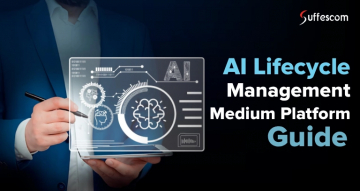Web3 Business Revenue Model | Unleashing New Business Models With Web3

Explaining Web3 to someone, nowadays, is akin to defining Facebook to someone in 1999.
Consider a new kind of Internet: one that is safe, decentralized, and free of Silicon Valley behemoths. That is Web3's promise, which is regarded as the next step in the evolution of the World Wide Web. The introduction of Web 3.0 (Web3) is posing significant obstacles and transforming the way businesses operate.
The forthcoming Web3 wave extends well beyond the first use case of cryptocurrency. Web3 connects data from individuals and corporations cryptographically with the richness of the interactions. Launching of Web3 applications leads to the rise of new fundamental markets and associated business models with efficient machine learning.
Web3 Revolution: A New Era Of Technology For Business
If you are an innovator looking for help with your Web3 innovation idea then Suffescom Solutions can help! Hire us, our techies are ready to build a next gen solution with a decentralized blockchain network.
Through this blog, you will get to know about the evolution of the web, the main features of Web3, and some real-time Web 3.0 examples. Furthermore, we will explore the most vivid Web3 technologies to unleash new business models with the modern Internet’s potential.
Let’s Get Started and Understand Web3 business Model!
Web 1.0 to Web 3.0 Evolution
The swift pace of technology development makes it feel like the Internet grew into what it is now in the blink of an eye. However, the Internet’s evolution process is carried out through many different stages during the 1990s.
Web 1.0
Web 1.0, often known as Internet 1.0 or the Client/Server Technology, is a centralized computer and information storage model that was introduced in 1995. In this version, data is stored and managed by a single computer system, with no real-time connection between computers.
Web 2.0
Web 2.0 is the second iteration of the internet, a web-based platform that allows users to create and share information via the internet. It ultimately came down to a decentralized data model, a large-scale computer network, and real-time communication between them.
Through blogs (and increasingly social media platforms), media sharing, and collaborative tactics, Web 2.0 allows people to share information.
The need for a new kind of Web, one closer to Tim Berners Lee's initial vision, rose over time.
Web 3.0: Its Features, and Benefits
Web 3.0 has its roots in the year 1991 in the papers by Tim Berners-Lee, the Web's founder, in which he endorsed a version of the Web that was substantially different from what we have now. Finally, Web 3.0 appears to be taking shape right before our eyes. This is the period in which computers can comprehend and interpret data and produce personalized content, and the web is built on decentralized technology.
Web 3.0 technology is a fair and transparent network that allows individuals to interact without fear of their security or privacy being compromised. The web version will make the internet intelligent while also making it semantic by integrating the capabilities of Artificial Intelligence and Big Data.
The future internet relies on the following features:
Web of Knowledge
Web 3.0, which is powered by artificial intelligence, includes tools and technology that allow computers to perceive and interpret information in the same way that humans do. These are traits and descriptors that are added to existing data and material to assist machines in processing it and extracting useful insights.
Decentralization
Web 2.0 stores data in centralized repositories, which is problematic for a number of reasons. In Web 3.0, data is stored on the blockchain in "blocks" and "nodes" spread over a huge network of computers. Because no single machine or server holds all of the data, decentralized access and many failure points are encouraged.
Security
Web 3.0 is a more secure version of its older sibling, Web 2.0. For example, decentralization makes it more difficult for unethical persons to gain access to large amounts of data. Users have more control over their information. Customers can select whether or not they wish to sell information about their online activities or remain anonymous.
Artificial Intelligence (AI)
One of the fundamental components of Web3 is Artificial Intelligence, which is infused into every app, technology, and workflow. AI development services are frequently used in modern web-based apps and services because it allows computers to replicate how people perceive and process data.
Flourish The Latest Web3 Solutions To Your Business Model
Looking to implement Web3 technology to increase revenue of your business? We are there to help! We take great pride in our ability to provide our clients with the best possible solutions to their business needs.
Web 3D Interactive
3D graphics and immersive experiences are woven into browsing experiences in the brand-new web world. In fact, modern digital site design relies heavily on technology like WebGL. Users may turn, spin, zoom in, and manipulate pictures in a variety of ways, bringing activities like gaming, studying, and online shopping to a whole new level.
Connectivity
Connectivity Web 3.0 is a system in which data connects everything - not just any data, but data that machines can comprehend. Visitors had previously been denied access to this information, but it has now been made available to workers and users in order to increase usability. As a result, a higher level of affinity is possible, allowing user experiences to automatically change to take advantage of the new information.
Ubiquity
The Internet is increasing quicker, and as a result, computers that are connected to the Internet are becoming more efficient. The Internet connects everything from Bluetooth devices to watches, drones, and lamps. A mobile phone or computer can be used to access the services at any time and from any location.
Autonomous
Businesses will have more autonomy with Web 3.0, as they will be able to specify their own terms and have them automatically executed without errors, decreasing the need for middlemen or attorneys. The machines will be able to interpret the transaction between two parties, making contract execution easier.
Censorship Resistance
Everything that is captured on Web 3.0 cannot be deleted or suspended by anybody, making it more trustworthy for users who want to share their data without fear of losing control at any time. As a result, businesses will save a lot of money by not having to pay a lot of money to secure their data and content from being hacked or stolen by cyber criminals.
These are the essential features that define Web 3.0. These features provide the most impactful innovations to the users. Have a look at these benefits:
No Restrictions Access
There will be no need to rely on any service providers in Web 3.0 because everything will be handled automatically by computers and smart gadgets. As a result, businesses will not have to pay excessive prices to access the services they require, lowering their operating costs and allowing them to do business more efficiently with customers and suppliers without wasting time.
Data Control & Ownership
The technology used in Web 3.0 enables users to have full control of their data. From a business standpoint, this will eliminate the need for enterprises to comply with onerous regulatory obligations because users will own their data completely. Clients will also be able to choose which parts of their personal data they are willing to disclose.
Compatibility
A lot of programs are tied to a specific operating system. Moreover, some IOS applications, do not operate on Android’s platform. For this, businesses need to develop separate software for the different operating systems. Web3’s dApps are there to solve this difficulty. These apps run on the blockchain and rely on the strength of peer-to-peer nodes. These programs can operate on any platform, which saves money and allows for greater scalability.
Anti-Monopoly
Web 3.0 features provide top-level privacy and anti-monopoly benefits to the users. It will not encourage centralized platforms that retain control over consumers' data. The dominance of digital corporations will disappear as individuals gain control over how their data is viewed, and there will be fewer to nil incidents of data privacy intrusions.
Unleashing New Business Models With Web3
If you look back ten years, you'll see that the early business models frequently try to duplicate Web 2.0 concepts. While there is some doubt regarding their practicality, we are confident that continued experimentation by some of the smartest builders will result in the creation of extremely valuable models in the future years.
We hope to learn how some of the more established and experimental Web 3.0 business models may accumulate value in the future years by investigating both existing and experimental Web 3.0 business models.
Search Online Target Customer
Web 3.0, often known as the semantic web, is an AI-driven web. It can decode the meaning of words and provide consumers with content that is personalized to their needs. Businesses can characterize internet content using semantic metadata. You can develop content that suits your user goal rather than jamming keywords into your material to rank higher on Google. Users will be able to find your products and services more easily as a result of this.
Customer Login Experience
Visitors to the website will have a smooth and straightforward login experience with the blockchain-powered web 3.0. We now frequently utilize our Facebook accounts to check in to a variety of other websites. As a result, Facebook owns your user data. Individuals, on the other hand, will be the owners of their data in web3.
Enhanced Customer Experience
In Web 3.0, the business provides a better user experience with some advanced tech like machine learning (ML) and artificial intelligence (AI). Business owners can focus on the human touch tasks, as advanced technologies can automate repetitive tasks.
Digital Payments
Web3 enables digital payments within the decentralized browser. The Brave browser, for example, is a fast, private, and secure web browser that provides users with a quick, ad-free browsing experience. It protects users to have safe and secure personal information by blocking such intrusive advertising and web services.
Web3 In Banking & Finance
At present, We need some trusted services like Banks or Paypal to make an online money transfer. With web3 banking app solutions, you'll be able to send money directly to anyone with an internet connection on a peer-to-peer basis.
Payment Tokens
With the rise of the token sale, a new wave of blockchain initiatives predicated their business models on payment tokens within networks, often forming two-sided marketplaces and requiring the usage of a native token for all payments.
Advertising
Users will be able to own their own data because of Web 3.0 technologies. They will have control over how their data is shared and sold. By authenticating impressions and clicks with the user's identification, Web3 technology will also eliminate ad fraud.
Streaming Industry
Streaming services like Netflix and Amazon Prime have become extremely popular and profitable in recent years. However, copyright issues and equitable compensation distribution to marketers and content creators are issues that this business faces. These problems can be solved with smart contracts in web 3.0.
Leverage The Power Of New Business Models With Web3
Our experienced blockchain technology developers can help you to implement web3 for the progress of your business. Get in touch with our developers now!
E-Commerce
To bring buyers and sellers together, marketplaces will no longer be reliant on central authority or platforms. Through open platforms, vendors would be able to sell their products and services directly to customers.
Web 3.0's Future!
Web 3.0 will revolutionize the way we interact with the digital world, and it won't simply affect individuals. The impact of Web 3.0 blockchain on traditional and innovative businesses will be enormous. The shift from Web 2.0 to Web 3.0, on the other hand, will take time. Businesses will have more time to think about their processes and decide where they want to be on the decentralization and transparency spectrum.
Suffescom Solutions is well-versed in providing web3 software development services and the technologies that drive the web's expansion. Do you want a free consultation on how Web 3.0 may help your company grow? Contact us right away!







